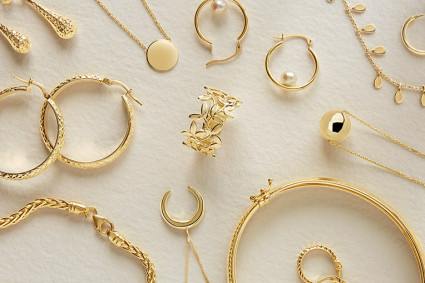**A Glimpse into History:**
The history of Indian jewellery dates back to ancient civilizations, with references found in texts like the Vedas and the Ramayana. From the intricate gold necklaces of the Indus Valley Civilization to the bejewelled treasures of the Mughal emperors, every era has left its imprint on Indian jewellery. Each piece tells a story of its time, embodying religious beliefs, social status, and regional aesthetics.
**Diverse Styles:**
One of the remarkable aspects of Indian jewellery is its sheer diversity. Every region boasts its own distinct style, influenced by local customs and available materials. For instance:
- **Kundan:** Originating in Rajasthan, Kundan jewellery features refined gemstones set in intricate gold foil settings.
- **Temple Jewellery:** Hailing from the temples of South India, this jewellery is characterized by its detailed motifs of gods, goddesses, and dancers.
- **Polki:** Similar to Kundan, Polki jewellery showcases uncut diamonds, often set in a more rustic manner.
- **Meenakari:** This technique involves enamelling on metal surfaces and is prominent in both Rajasthan and Varanasi.
- **Navratna:** A traditional style that involves setting nine different gemstones together for their astrological significance.
**Craftsmanship at Its Finest:**
Indian jewellery is a testament to the exceptional skills of artisans who have passed down their knowledge through generations. From intricate filigree work to delicate stone settings, these craftsmen invest countless hours and unwavering dedication into creating pieces that are true works of art. Their hands bring life to metal, stones, and enamel, transforming them into exquisite creations.
**Symbolism and Rituals:**
Indian jewellery is more than just embellishment; it often carries profound symbolism. Maangtikas worn on the hairline signify the union of the bride and groom, while toe rings are a symbol of a married woman. Nose rings, armlets, and anklets all hold cultural and ritualistic significance, reflecting beliefs and traditions that have been upheld for centuries.
**Evolving Trends:**
While traditional Indian jewellery remains evergreen, modern designs are also gaining traction. Contemporary jewellers are infusing new elements into classic pieces, creating a fusion of tradition and innovation. This blend caters to changing tastes while preserving the essence of Indian aesthetics.
**Global Appeal:**
The allure of Indian jewellery has transcended geographical boundaries. From Hollywood red carpets to fashion runways, the intricate designs and vibrant gemstones have captured the attention of the world. Bollywood's influence has also played a significant role in popularizing Indian jewellery globally.
**Conclusion:**
Indian jewellery is a celebration of artistry, culture, and heritage. Its timeless beauty not only graces special occasions but also serves as a connection to India's illustrious past. As we continue to embrace the elegance of Indian jewellery, we honor the legacy of skilled artisans and the stories woven into each piece, bridging the gap between tradition and modernity.


